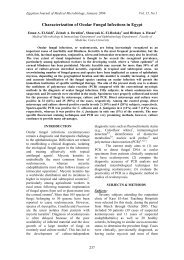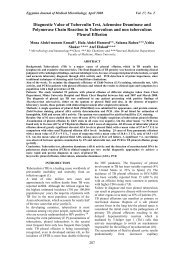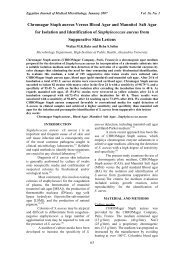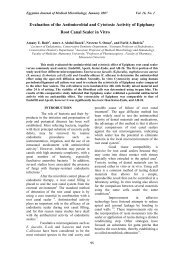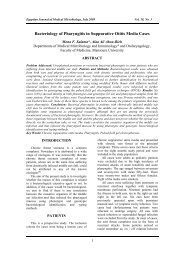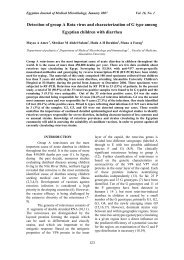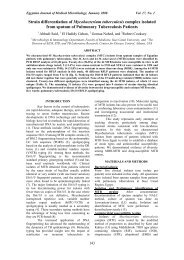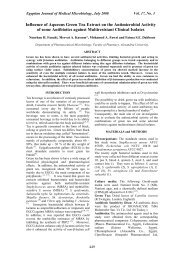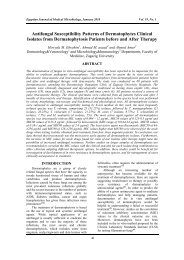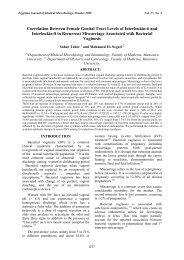Renal Tuberculosis as an Aetiology of Sterile Pyuria - The Egyptian ...
Renal Tuberculosis as an Aetiology of Sterile Pyuria - The Egyptian ...
Renal Tuberculosis as an Aetiology of Sterile Pyuria - The Egyptian ...
Create successful ePaper yourself
Turn your PDF publications into a flip-book with our unique Google optimized e-Paper software.
Egypti<strong>an</strong> Journal <strong>of</strong> Medical Microbiology, July 2009 Vol. 18, No. 3Table (1): Results <strong>of</strong> microscopic examination <strong>an</strong>d Bayer reagent stripsControls (n=10) Patients (n=50) P valueBayer reagent stripsProteinBloodLeucocyte ester<strong>as</strong>eNitriteUrine examinationWBCsRBCs3 (30%)0 (0%)0 (0%)0 (20%)5±0.524±0.67P value signific<strong>an</strong>t between patients <strong>an</strong>d controls.* p
Egypti<strong>an</strong> Journal <strong>of</strong> Medical Microbiology, July 2009 Vol. 18, No. 3DISCUSSIONInfection is a common cause <strong>of</strong> morbidity<strong>an</strong>d mortality in haemodialysis patients, beingthe cause <strong>of</strong> 23% <strong>of</strong> deaths <strong>an</strong>d 22% <strong>of</strong>hospitalizations (14) .Haemodialysis patients are moresusceptible to UTIs. When undiagnosed <strong>an</strong>duntreated, signific<strong>an</strong>t complications may occurleading to the need <strong>of</strong> drainage procedures,nephrectomy or deaths. Delayed diagnosis is arelev<strong>an</strong>t issue because UTI is <strong>of</strong>ten overlooked<strong>as</strong> source <strong>of</strong> infection in dialysis patients,especially because its symptoms are mostlyrelated to voiding which is reduced or absent.When diagnosed in a timely m<strong>an</strong>ner, theseinfections are e<strong>as</strong>ily treatable, <strong>an</strong>d earlytreatment prevents further complications (3) .In the present study, the rate <strong>of</strong> UTI inhaemodialysis patients w<strong>as</strong> signific<strong>an</strong>tly higherth<strong>an</strong> in controls. <strong>The</strong> prevalence w<strong>as</strong> recorded<strong>as</strong> 38% <strong>an</strong>d 0% in patients group <strong>an</strong>d controlsrespectively. This agrees with Eisinger et al. (3)who stated that haemodialysis patients havecompromised immunity <strong>an</strong>d are at high risk <strong>of</strong>UTI. Orlowska et al. (6) have also reported thatimmune system disturb<strong>an</strong>ce <strong>an</strong>d renal failurec<strong>an</strong> predispose to UTIs in continuousambulatory peritoneal dialysis patients.<strong>The</strong> number <strong>of</strong> WBCs in urine is a usefulmarker <strong>of</strong> UTI in patients with renalinsufficiency, while its value in haemodialysispatients is unclear <strong>an</strong>d not mentioned in urologytextbooks (15) . Kim <strong>an</strong>d Corwin (5) reported thatthe value <strong>of</strong> pyuria <strong>as</strong> a marker <strong>of</strong> UTI indialysis patients is questionable. This is because<strong>of</strong> several clinical factors that may confoundthis relationship, <strong>an</strong>d the observations <strong>of</strong> someauthors that the presence <strong>of</strong> pyuria in thesepatients is not indicative <strong>of</strong> infection.Confounding clinical factors include: thepresence <strong>of</strong> low urine volume, bladder st<strong>as</strong>is<strong>an</strong>d the underlying aetiology <strong>of</strong> kidney dise<strong>as</strong>e.<strong>The</strong> latter factor leading to terminal kidneyfailure is <strong>as</strong>sociated with sterile pyuria owing tochronic parenchymal inflammation. For furtherinformation, the present study w<strong>as</strong> designed to<strong>as</strong>sess the diagnostic relev<strong>an</strong>ce <strong>of</strong> pyuria inhaemodialysis patients.In our study, the cut <strong>of</strong>f used for diagnosingpyuria w<strong>as</strong> ≥5 cells/hpf. Kim <strong>an</strong>d Corwin (5)have used this new cut <strong>of</strong>f <strong>as</strong> a st<strong>an</strong>dard forpyuria <strong>an</strong>d they criticized most researchers forconsidering a cut <strong>of</strong>f <strong>of</strong> ≥10 cells/hpf in theirstudies. In addition, F<strong>as</strong>olo et al. (2) denied most<strong>of</strong> studies for using the old cut <strong>of</strong>f st<strong>an</strong>dard, <strong>an</strong>dthey believed that their results might differwhen using the new st<strong>an</strong>dard cut <strong>of</strong>f.Our results demonstrate that WBCs countin a r<strong>an</strong>dom urine sample w<strong>as</strong> signific<strong>an</strong>tlyelevated in haemodialysis patients compared tocontrols with <strong>an</strong> average <strong>of</strong> 28 cell/hpf inpatients compared to 4 cells/hpf in controls(p
Egypti<strong>an</strong> Journal <strong>of</strong> Medical Microbiology, July 2009 Vol. 18, No. 3urine <strong>of</strong> haemodialysis patients using a cut <strong>of</strong>f≥10 cells. <strong>The</strong>y reported that pyuria is notappropriate to be a marker for bacterial infectionin these patients. <strong>The</strong> conclusion <strong>of</strong> these twogroups <strong>of</strong> investigators may be attributed to theuse <strong>of</strong> the old cut <strong>of</strong>f st<strong>an</strong>dard <strong>of</strong> ≥10 cells/hpf.<strong>The</strong>ir results could be different if they used thenew cut <strong>of</strong>f st<strong>an</strong>dard ≥5 cells/hpf.Urinalysis for pyuria <strong>an</strong>d infection w<strong>as</strong>screened by Bayer's reagent strips. Leukocyteester<strong>as</strong>e (LE) w<strong>as</strong> signific<strong>an</strong>tly higher in urine<strong>of</strong> haemodialysis patients th<strong>an</strong> that <strong>of</strong> controls(p
Egypti<strong>an</strong> Journal <strong>of</strong> Medical Microbiology, July 2009 Vol. 18, No. 33. Eisinger RP, Asghar F, Kol<strong>as</strong>a C, et al.(1997): Does pyuria indicate infection in<strong>as</strong>ymptomatic dialysis patients? ClinNephrol; 47:50-51.4. Cabuluna CC, Gary NE <strong>an</strong>d Eisinger RP(1977): Urinalysis in patients on chronichaemodialysis. Urology; 10: 103-104.5. Kim SM <strong>an</strong>d Corwin HL (2007):Urinalysis. In: Dise<strong>as</strong>es <strong>of</strong> the Kidney <strong>an</strong>dUrinary Tract. Schrier RW. (Ed). LippincottWilliams <strong>an</strong>d Wilkins. Philadelphia USA.7 th ed. pp 286-298.6. Orlowska A, Majd<strong>an</strong> M <strong>an</strong>d Koziol-Montewka M (2002): Asymptomaticbacteriuria in patients on continuousambulatory peritoneal dialysis. Ann UnivMariae Curie Sklodowska; 57: 285-289.7. Chaudhry A, Stone WJ <strong>an</strong>d Breyer JA(1993): Occurrence <strong>of</strong> pyuria <strong>an</strong>dbacteriuria in <strong>as</strong>ymptomatic haemodialysispatients. Am J Kid Dis; 21: 180-183.8. Alvarez S <strong>an</strong>d McCabe WR (1984): Areview <strong>of</strong> experience at Boston CityHospital <strong>an</strong>d other hospitals. Medicine; 63:25.9. Lin JN, Lai CH, Chen YH, et al. (2009):Risk factors for extrapulmonarytuberculosis compared to pulmonarytuberculosis. Int J Tuberc Lung Dis; 13 (5):620-625.10. Kathleen D, Eisenach M, Donald C, et al.(1993): PCR detection Mycobacteriumtuberculosis. In: Diagnostic molecularmicrobiology; Principles <strong>an</strong>d applications.Persing DH, Smith TF, Tenover FC <strong>an</strong>dWhite TJ (Eds). Americ<strong>an</strong> Society forMicrobiology. W<strong>as</strong>hington DC, USA. pp191-220.11. Innis MA, Gelf<strong>an</strong>d DH, Sninsky JJ, et al.(1990): PCR protocols. In: A guide tomethods <strong>an</strong>d applications. Acadimic Pressinc., S<strong>an</strong> Diego, CA. pp 4-36.12. Sambrook J <strong>an</strong>d Russell DW (2001):Molecular cloning. In: A laboratorym<strong>an</strong>ual. Cold spring harbor LaboratoryPress. NY. 3 rd ed. Vol. III. pp 5.14-5.18.13. Ayers L (2007): Microscopic examination<strong>of</strong> infected material. In: DiagnosticMicrobiology. Connie RM, Donald CL <strong>an</strong>dGeorge M (Eds). Sauder, Missouri USA. 3 rded. pp 152-198.14. Allon M, Radeva M, Bailey J, et al.(2005): <strong>The</strong> spectrum <strong>of</strong> infection-relatedmorbidity in hospitalized haemodialysispatients. Nephrol Dial Tr<strong>an</strong>spl<strong>an</strong>t; 20:1180-1186.15. Hyodo T, Yoshida K <strong>an</strong>d Sakai T (2005):Asymptomatic hyperleukocyturia inhaemodialysis patients <strong>an</strong>alyzed by theautomated urinary flow cytometer. <strong>The</strong>rAlpher Dial; 9: 402-406.16. Nicolle LE (2003): Asymptomaticbacteriuria when to screen <strong>an</strong>d when totreat. Infect Dis Clin North Am; 17 (2):367-394.17. Saitoh H, Nakamura K, Hida M, et al.(1985): Urinary tract infection in oliguricpatients with chronic renal failure. J Urol;133: 990-993.18. Tolk<strong>of</strong>f-Rubin N, Catron C <strong>an</strong>d RobertR (2008): Urinary Tract Infection,Pyelonephritis, <strong>an</strong>d Reflux Nephropathy.In: <strong>The</strong> Kidney. Brenner BM (Ed). John F.Kennedy Blvd. Philadelphia. 8 th ed. pp1203-1238.19. E<strong>as</strong>twood JB, Corbishley CM <strong>an</strong>dGr<strong>an</strong>ge JM (2001): Dise<strong>as</strong>es <strong>of</strong> the month,tuberculosis <strong>an</strong>d kidney. J Am Soc Nephrol;12: 1307-14.20. Säv T, Tokgoz B, Sipahioglu MH, et al.(2009): Extrapulmonary tuberculosis inhaemodialysis patients with unusual clinicalpresentation. Int Urol Nephrol; 9540-9542.21. Marques LP, Rioja LS, Pacheco GG, etal. (2008): <strong>Tuberculosis</strong> in haemodialysispatients in area <strong>of</strong> high incidence <strong>of</strong>Mycobacterium tuberculosis <strong>an</strong>d hum<strong>an</strong>immunodefeciency virus infection. Dial &Tr<strong>an</strong>spl<strong>an</strong>t; 37 (12): 486-490.25
Egypti<strong>an</strong> Journal <strong>of</strong> Medical Microbiology, July 2009 Vol. 18, No. 3القيمة التشخيصية لوجود الخلايا الصديدية في البول في مرضي الأستصفاء الدموي[الدرن الكلوي آسبب في تواجد الخلايا الصديدية في البول دون نمو بكتيري علي المزارع]٣١٢٢١محمد صابر ، ليلي أبو الفضل ، هدي حلمي ، إيهاب الضبع ، إمام واآد ، عزة الشماع١أقسام الكيمياء الحيويةمنار حسين ، داليا رشد، بحوث الكلي معهد تيودور بلهارس والباطنة،٣٤٤٣٣٢، الميكروبيولوجيجامعة القاهرةصممت هذه الدراسة لتقييم وجود الخلايا الصديدية في البول آدليل علي عدوى المسالك البولية في مرضيالأستصفاء الدموي، وتقييم الدرن الكلوي آسبب سائد لوجود الخلايا الصديدية في البول دون نمو بكتيري علي المزارع٠اشتملت الدراسة علي خمسين مريض يعانون من الفشل الكلوي المزمن لأمراض الكلى ويجرى لهم الأستصفاءالدموي بشكل منتظم (مجموعة أ)٠ آما يشمل البحث مجموعة ضابطة مكونة من عشرة أشخاص أصحاء (مجموعة ب)٠تم زرع عينات البول، وفحصها ميكروسكوبيا للكشف عن الخلايا الصديدية، واختبارها بشرائط اختبارreagent للكشف عن البروتين، خلايا الدم، النيتريت وأنزيم ٠Leucocyte ester<strong>as</strong>e آما تم صبغ المستعمرات البكتيريةبصبغة الجرام والتعرف عليها باستخدام اختبار ٠API20Eتم تجميع بول ٢٤ ساعة ودورانه واستخدام الراسب في صبغة Ziehl-Neelson للكشف عن عصويات الدرنالمقاومة للكحول والحامض٠ آما استخدم الراسب في اختبار تفاعل البلمرة المتسلسل PCR للكشف عن الحامض النوويلميكروب الدرن٠قد أسفرت نتائج البحث عن وجود الخلايا الصديدية في بول جميع المرضي بنسبة أآثر من خمس خلايا في الحقلالمجهري٠ آما أن نسبة البروتين، وخلايا الدم، وأنزيم Leucocyte ester<strong>as</strong>e والنتريت، آانت جميعها أعلي في مجموعةالمرضي عن المجموعة الضابطة، وآانتوجود علاقة ذات دلالة إحصائية بين أعراض المريض والنمو البكتيري (0.01>p). من بين واحد وثلاثون مريض يعانونمن وجود الخلايا الصديدية بالبول مع عدم وجود نمو بكتيري علي مزارعهم، ثلاثة مرضى تم تشخيصهم آمرضيالدرن الكلوي عن طريق صبغة Ziehl-Neelson أو اختبار تفاعل البلمرة المتسلسل ٠PCRيستنتج من البحث أن وجود الخلايا الصديدية في البول سائد بين مرضى الأستصفاء الدموي٠ آما ثبت أهميته آدليلعلي وجود عدوى المسالك البولية٠ ولذلك في المرضى الذين يعانون من أعراض عدوى المسالك البولية وتتواجد الخلاياBayerP. value علي التوالي



